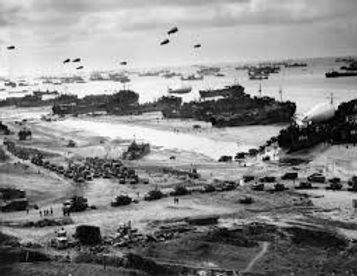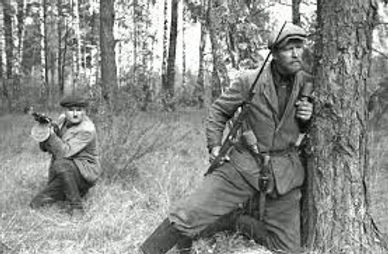The German Retreat and Allied Advance

From 1943-1944 The German army had been stalled at Stalingrad and subsequently routed by the Russians. Meanwhile the Americans and British pushed the Germans out of North Africa and Sicily. On June 6th, 1944 Allies launched Operation Overlord the landing at Normandy officially opening up the second front. This would cause the already strained German army to begin to be pushed back on all fronts. Despite this the Nazis would become ever more brutal by ramping up killing centers and also anti-partisan assaults.(Bergen Doris “War and Genocide”) To the Jewish partisan the general retreat must have felt like victory after their long and bloody fight but for some this was not a victory as it led to more direct soviet control as well as the increasing boldness of other anticommunist units like the Polish AK army that were not fond of Jewish partisan units as well as soviet units. ( "Jewish partisan." Britannica Library)


(Above Picture) Russian Armor- "T34-85 series tanks) and infantry likely a "Guards brigade" or "Shock" unit counterattacking winter (1944)
(Below Picture) Allied Forces landing at Normandy after D-Day
In Western Europe
In Eastern Europe
In eastern Europe the German army faced a massive Soviet onslaught. Millions of Soviet troops began to push towards Germany to put an end to the Third Reich once and for all. The Soviets began to directly organize all Soviet partisan units underneath one command beginning in 1942. Over time the Soviets would include Jewish partisans into the umbrella of their command the Bielski partisans most notably would work directly with soviet commanders and units to take actions inside Poland. By 1943-44 The Soviets eager to build larger units began to recruit more diverse groups. This opened up opportunities for Jewish men who wished to fight in Soviet units. However, this also led to the acceptance of men who had been pro-Nazi prior and flipped sides. These men who harbored anti-Semitic views would in some instances gain positions of authority further causing tension. This combined with increased German infiltration of Soviet units and direct assaults would lead to a paranoia in some units about Jewish partisans as spies, we can assume with relative accuracy most of the spies and agents were the same individuals who had a pro-Nazi past. (Nechama Tec. “Defiance The Bielski Partisans”)
A rise in anti-Semitism from new recruits and some leadership would not be the only issues Jewish partisans would face in the east. In Poland and other areas where soviet units operated, they brought with them the communist doctrine. This pretty much meant subverting Jewish units with communist agents and putting communists into leadership positions for those Jews who were not communist this was not welcomed whole heartedly but was accepted as a reality. Due to communist doctrine of rich vs poor Jews who were once rich or wealthy were cast down as “malbush” in some full Jewish partisan units. This created some discontent within units as there was a new class divide formed and encouraged by communist doctrine. (Nechama Tec. “Defiance The Bielski Partisans”)
Outside of these issues there were frequent assaults by soviet units and especially polish units like the Home Army that created other issues outside of the threat of German attacks on the forest enclaves. Many assaults on women occurred and men were murdered at random by drunk partisans or anti-Semitic individuals.
Overall though despite these issues the soviets did bring a semblance of order and prevent a full out partisan vs partisan war from occurring in the background between AK units and Jewish / Soviet units. The Soviets brought with them a level of an organization that was quite impressive despite their massive bureaucratic and political apparatus. They did not just create interconnected enclaves to support each other but the development of airfields to airlift in supplies and individuals. This allowed the equipment shortages to improve although many Jewish partisans still had to purchase their equipment or barter unlike their soviet brethren. The development of organized enclaves also helped alleviate food shortages and reduced the amount of raiding on the peasantry necessary. (Nechama Tec. “Defiance The Bielski Partisans”)
Jewish Partisans working within Soviet units or in their own units would carry out thousands of sabotage acts over the end of the war, these included hits on bridges, supply convoys as well as German agents. These units would also be responsible for helping to save thousands of Jewish lives and escapes from or other groups that would seek to murder them.
As the war progressed in western front and the German lines began to crumble to the allied advance, resistance began to be reinvigorated. Armed Jewish partisans now emboldened by the weakening German control sought to take advantage of this to make a significant difference. France in particular became a hotbed of partisan activities as the partisan units now fully matured into real organizations with definitive goals and structure. They were able to carry out many actions against German supply lines and communications networks hampering the Germans ability to coordinate actions on the front.
Most notable of these groups during this later period were the Isrealites de France aka (EIF) Armee Juive aka (AJ) and the Jewish Fighting Organization aka (OJC) these three groups operated in concert to disrupt German activities by force and peaceful means. The combined AJ-OJC are estimated to have numbered almost 2,000 strong around 1944, this included a network of mountain gorillas in the pyrenes to city units in Paris, Marseilles, Toulouse and Grenoble. This large network would claim credit for over 1,925 acts of sabotage mostly after the June 6th landings at Normandy. These acts of sabotage include the destruction of 32 Nazi factories and damage to 25 others as well as 750 attacks on railways; this however did come with a cost over 1,000 OJC members would die a casualty rate over 50%. They would also help move hundreds of young Jews to Spain to join up with allied forces to fight in the war directly as well as helped hide over 7,000 children with the aid of other Christians sympathetic to their cause. ( "Jewish partisan." Britannica Library)
Jews elsewhere in Holland and Belgium also participated in sabotage but this was very limited due to terrain and other political issues which made most armed actions difficult to undertake or discouraged. ( "Jewish partisan." Britannica Library)Overall Jewish partisans in the west by the later years of the war were doing very well and taking important actions that helped to cripple the German war machine. This success can be attributed to the support of locals as well as adequate equipment and knowledge of their terrain. With the support of many locals these units were able to remain active in areas they most likely had lived in which helped to make their activities whether overt or covert even more successful.

(Opposite picture) Soviet partisans in woods eastern Europe
German Response

Opposite picture) German soldiers carrying a wounded soldier (1941)

During the later stages of the war the Germans began to realize the threat that all the partisans including the Jewish units posed to their war effort. After much failed attempts by police units the Germans would launch in summer 1943 in Poland a campaign to eliminate and crush all Jewish and Soviet units in the Nalibocka forest. On August 1st, 1943 the Germans launched an assault on the Partisan units in the area among them were several Jewish Partisan Units among them the Bielski brothers. (Nechama Tec. “Defiance The Bielski Partisans”)
In an attempt to delay German forces, they mined the roads and set up enfilading fire positions on the sides of the roads hoping to stall German units. The Germans quite concerned by the partisan activities committed divisions directly from the front lines in order to flush out these units. The partisans unfortunately were not able to withstand the German assault and were forced to retreat out of the woods many would die in the ensuing confusion. As one Jewish partisan spoke about an ambush during this assault “As a truck with thirty Germans approached, it exploded. Hey all flew into the air. All were killed. This was on the road leading to the Nalibocka forest. But after two days we realized that we could not fight them openly. They were a well-equipped army and we did not have enough power.” (115-116 Tec) In this particular engagement several hundred Jewish fighters would participate valiantly. Despite the setback the partisan units who remained would regroup and move elsewhere to fight another day. The Germans would launch many actions like this in a futile effort to crush partisan units. (Nechama Tec. “Defiance The Bielski Partisans”)
As the Germans retreated from areas, they would burn villages and crops and assault any enclaves they found. This however did not impact the partisans much as by this point eastern partisans had become quite adept at surviving in the wilderness.
In the west German anti-partisan activities were more subdued. After the breakout of the Bocage the German line collapsed very quickly preventing the Germans from diverting resources to take any organized anti- partisan actions in many cases. Also, the fact that partisan units were well imbedded into their communities in the west made targeting them hard without infiltration as they were very well supported by British intelligence and the local populace.